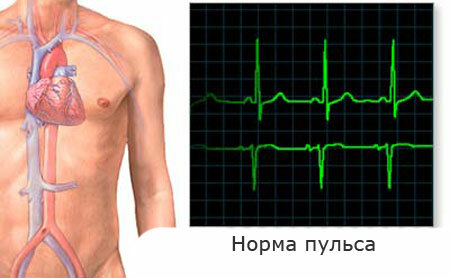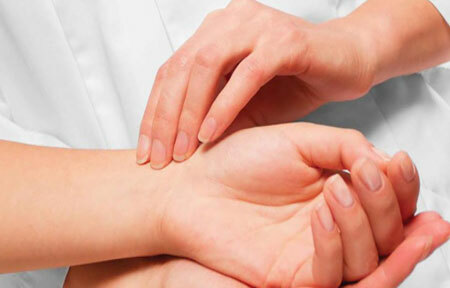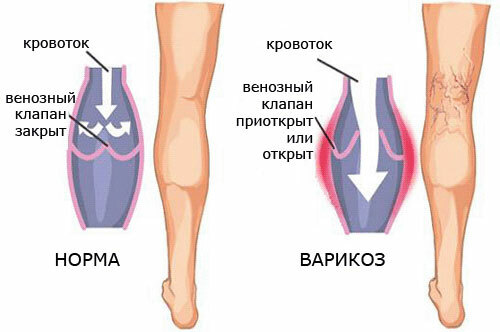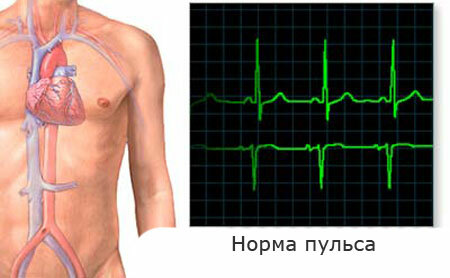The pulse rate is an important indicator in assessing the performance of the heart. Its definition is a component in the diagnosis of arrhythmia and other diseases, sometimes quite serious. This publication examines the methods of measuring the pulse, the age norms for adults and children, and the factors that influence its change.
Contents of
- 1 What is the pulse?
- 2 How is the pulse measured?
- 3 What affects the heart rate?
- 4 Table of the pulse rate by age in women and men
- 5 When the pulse rate is high?
- 6 What is a bradycardia?
What is the pulse?

Pulse is an oscillation of the vascular walls that arise as a result of contractions of the heart muscles. This indicator allows us to evaluate not only the strength and rhythm of the heartbeat, but also the state of the vessels.
In a healthy person, the intervals between pulsations should be the same, the unevenness of the same cardiac strokes is regarded as a symptom of violations in the body - it can be both a pathology of the heart and another disease, for example, a malfunction in the endocrine glands.
Pulse is measured by the number of pulse waves, or beats, per minute and has certain values - in adults it is from 60 to 90 at rest. The pulse rate in children is somewhat different( the indicators are presented in the table below).
How is the pulse measured?

The pulse is measured by pulsating blood in the radial artery, more often on the suture from the inside, since the vessel in this place is closest to the skin. For maximum accuracy, the indicators are recorded on both hands.
If there are no rhythm disturbances, then it is enough to calculate the pulse in 30 seconds and multiply it by two. If the heart beats are irregular, then it is more appropriate to count the number of pulse waves in a minute.
In more rare cases, counting is performed in places of passage of other arteries - humeral, femoral, subclavian. Measure the pulse can be, attaching fingers to the neck at the place of passage of the carotid artery or to the temple.
If you need a thorough diagnosis, for example, if serious diseases are suspected, other tests are performed to measure the pulse - Voltaire mount( counting per day), ECG.
A so-called treadmill test is used when heart work and blood ripples are recorded by an electrocardiogram while the patient is moving on a treadmill. This test also shows how quickly the normal work of the heart and blood vessels after exercise.
What affects the heart rate?
If the norm of the pulse in women and men at rest remains within the range of 60-90, for many reasons it may temporarily increase or acquire somewhat higher constant values.
This is affected by age, physical activity, eating, changing body position, temperature and other environmental factors, stresses, release of hormones into the blood. The number of pulse waves arising per minute is always dependent on the number of heartbeats( abdominal heart rate) during the same time.
Usually, the pulse is normal for men at 5-8 strokes below that of women( 60-70 per minute).The normal indices in children and adults differ, for example, in a newborn child, a pulse of 140 beats is considered normal, and for an adult it is a tachycardia that can be either a temporary functional condition or a sign of heart disease or other organs. The heart rate depends on daily biorhythms and is the highest in the period from 15 to 20 h.
Table of the pulse rate by age in women and men
| Age | Pulse min-max | Mean value | Blood pressure norm( systole / diastole) | |
| Women | Male | |||
| 0-1 month | 110-170 | 140 | 60-80 / 40-50 | |
| From 1 month.up to the year | 102-162 | 132 | 100 / 50-60 | |
| 1-2 years | 94-155 | 124 | 100-110 / 60-70 | |
| 4-6 | 86-126 | 106 | ||
| 6-8 | 78-118 | 98 | 110-120 /60-80 | |
| 8-10 | 68-108 | 88 | ||
| 10-12 | 60-100 | 80 | 110-120 / 70-80 | |
| 12-15 | 55-95 | 75 | ||
| Adults up to 50 years of age | 60-80 | 70 | 116-137 / 70-85 | 123-135 / 76-83 |
| 50-60 | 65-85 | 75 | 140/80 | 142/85 |
| 60-80 | 70-90 | 80 | 144-159 / 85 | 142 / 80-85 |
In the table of the standardpressure and pulse rate by age, the values for healthy people at rest are indicated. Any changes in the body can provoke a deviation in the frequency of cardiac contractions from these indicators in one direction or another.
For example, during menopause, a physiological tachycardia and a slight increase in pressure are observed in women, which is due to a change in the hormonal background.
When is the pulse high?

In the absence of pathological changes affecting the frequency of heart beats, the pulse may increase under the influence of physical exertion, whether it is intensive work or playing sports. The following factors can also increase it:
- stress, emotional impact;
- overwork;
- hot weather, stuffiness indoors;
- strong pain.
With a functional increase in heart rate, there is no shortness of breath, dizziness, headaches and chest pains, it does not darken in the eyes, the heart rate remains within the maximum norm and returns to the usual value 5-7 minutes after the cessation of exposure.
About pathological tachycardia, say if there is any disease, for example:
- cardiac and vascular pathology( for example, a frequent pulse in hypertensive patients, persons with ischemic disease);
- arrhythmia;
- nerve pathology;
- heart defects;
- presence of tumors;
- infectious diseases, fever;
- hormonal disorders;
- anemia;
- profuse menstruation( menorrhagia).
Some increase in the number of pulse waves is observed in pregnant women. In children, functional tachycardia is the norm, noted during active games, sports and other activities, and allows the heart to adapt to changing conditions.
An increase in the heart rate, and therefore a high pulse, is observed in adolescents with vegetative-vascular dystonia. During this period, it is important to pay close attention to any changes - chest pain, slight shortness of breath, dizziness and other symptoms serve as an excuse to show the child to the doctor, especially if there are diagnosed heart diseases.
What is a bradycardia?

If tachycardia is called increased heart rate, then bradycardia - it's low compared with the norm( less than 60 pulsations per minute).Depending on the reasons, it can be functional and pathological.
In the first case, the pulse is decreased during sleep and in trained people - in professional athletes, even 40 strokes is considered a norm. For example, in the Lance Armstrong racer he is within 35-38 pulsations.
Reduction of the pulse is also a manifestation of heart and vessel diseases - a heart attack, age-related pathological changes, inflammation of the heart muscle. This is a cardiac bradycardia, caused in most cases by a violation of the impulse between the nodes of the heart. At the same time, tissues are poorly supplied with blood, oxygen starvation develops.
Concomitant symptoms include weakness, dizziness, fainting, cold sweat, unstable pressure.
Bradycardia also develops due to hypothyroidism, stomach ulcers, myxedema, with increased intracranial pressure. A pronounced bradycardia is less than 40 strokes, this condition often causes the development of heart failure.
If the frequency of strokes is reduced and the causes are not detected, then the bradycardia is called idiopathic. There is also a dosage form of this disorder, when the pulse decreases after taking pharmacological preparations, for example, Diazepam, Phenobarbital, Anaprilin, valerian tincture or motherwort.
With age, the heart and blood vessels wear out, become weaker, and the abnormality of the pulse from the norm is diagnosed in many people after 45-50 years. Often this is not only a physiological feature, but also a symptom of serious changes in the work of organs. Therefore, in this age period it is especially important to regularly visit a cardiologist and other specialists to monitor and treat existing diseases and timely identify new health problems.



